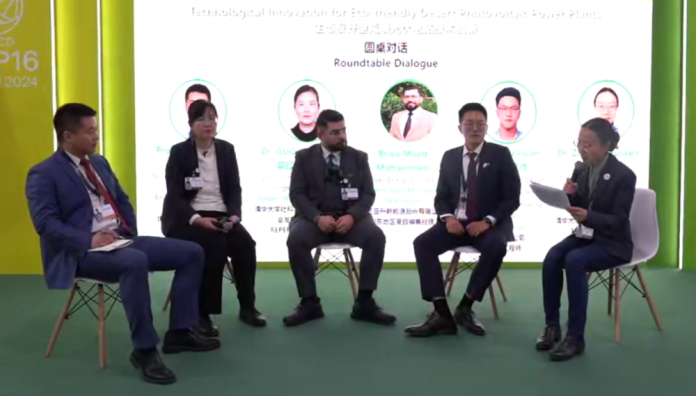[International Energy Network Live Report] The COP16 China Pavilion held a side event under the theme of “Technological Innovation for Eco-friendly Desert Photovoltaic Power Plants” on the afternoon of December 11th, in Riyadh, Saudi Arabia. The conference was hosted by the Center for Energy Transition and Social Development of the School of Social Sciences of Tsinghua University, co-hosted by the Xinjiang Institute of Ecology and Geography of Chinese Academy of Sciences,China Renewable Energy Engineering Institute and International Energy Network.
Representatives from Xinjiang Institute of Ecology and Geography of the Chinese Academy of Sciences, TBEA Xi’an Electric Technology, Risen Energy, Solar Space Technology, Solarsure Technology, Shanghai Jinyou Jinhong Intelligent and other companies attended the meeting.
The guests focused on the hot and difficult issues in the construction and management of desert photovoltaic power plants, and discussed how to achieve eco-friendly development of photovoltaic power plants through technological innovation.
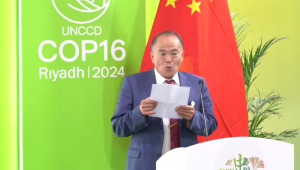
Xu Xinwen, researcher of Xinjiang Institute of Ecology and Geography, Chinese Academy of Sciences
Xu Xinwen, researcher at Xinjiang Institute of Ecology and Geography of the Chinese Academy of Sciences, delivered a speech at the opening of the conference. In his speech, he emphasized: “The prominent contradiction between power station construction and the fragile ecological environment is becoming increasingly prominent. Therefore, how to integrate the development of photovoltaic power stations and desert ecological industries is one of the important issues that must be solved in the future development of desert photovoltaics. I hope that new energy companies will continue to strengthen cooperation and innovation. Give full play to the technical advantages of the institute in the field of desertification textiles and contribute to the integrated development of eco-friendly photovoltaic power stations and desert photovoltaic ecological industries!”
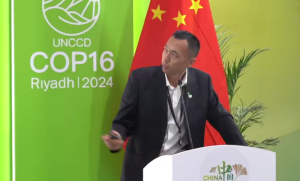
Fan Jinglong, Professor Xinjiang Institute of Ecology and Geography, Chinese Academy of Sciences
Fan Jinglong, senior engineer of the Xinjiang Institute of Ecology and Geography, Chinese Academy of Sciences, delivered a keynote speech entitled “Thoughts and Actions on the Integrated Development of Photovoltaics and Sand Control in Xinjiang, China”. He pointed out that the integration of China’s photovoltaic power generation construction and desertification prevention and control is developing rapidly, and China has great potential in the development of solar power generation. In 2024, Xinjiang’s new energy installed capacity will be about 20 million kilowatts, ranking first in China at the same time. However, due to the influence of strong wind and sand in Xinjiang, local photovoltaic power stations face challenges. To meet the challenge, China plans to build an 800-kilometer-long solar “Great Wall” with an installed capacity of 100 million kilowatts around the Taklimakan Desert in Xinjiang to prevent desertification in Xinjiang. ”
Chirag, Electrical Engineer TBEA Xi’an Electric Technology Co., Ltd, gave a speech on the theme of “With the Wind and in the Light – TBEA New Energy Focuses on the Green Development of the World”.
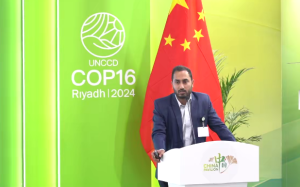
Chirag, Electrical Engineer TBEA Xi’an Electric Technology Co., Ltd.
He first introduced the four major directions of TBEA’s business scope, which are power transmission and transformation, traditional energy, new energy and new materials. Then he proposed TBEA’s solution for the pain points of power demand in the Middle East, which are the large power gap and frequent power outages. By using its core product string energy storage inverter, TE215K-HV has a maximum efficiency of 99%, a protection level of IP66, a corrosion resistance level of C5, and a long-term overload capacity of 1.1 times to ensure the safety of the energy storage system. It uses high-quality IGBT components from well-known brands such as Infineon and ON Semiconductor to ensure product reliability and provide more high-quality services for the high-quality development of energy storage in the Middle East.
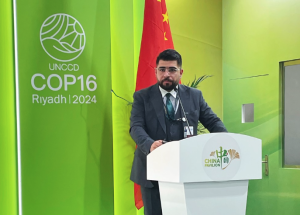
Brwa Majid Mohammed, Senior Sales Manager, MEA region Risen Energy Co., Ltd
Brwa Majid Mohammed, Senior Sales Manager, MEA region Risen Energy Co., Ltd, introduced the basic situation of Risen Energy Co., Ltd., and combined with the verification results of authoritative institutions and empirical data, he explained the technical innovation and excellent performance of the company’s heterojunction Fuxi modules. Brwa Majid Mohammed said: Risen Energy has achieved the first mass production in the industry through its independently developed 0BB battery technology and 210 ultra-thin silicon wafer technology. In terms of TOPCon battery technology, the company uses a new contact passivation process, optimizes the activation process, and improves battery efficiency.
With the support of mature technology and processes, Risen Energy’s innovative heterojunction Fuxi modules based on the 210+ heterojunction technology platform have a maximum power of 767.38Wp and a module conversion rate of 24.7%, reaching the highest level in the current field.
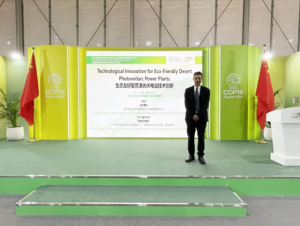
Akram, Sales Manager in South East Region of Solar Space Technology Co.,Ltd.
Akram, Sales Manager in South East Region of Solar Space Technology Co.,Ltd, took the theme of “Technological Innovation Drives the Efficiency Revolution of Desert PV Power Stations” to show the production capacity layout and product advantages of Zhongrun Solar to the audience. Akram said that Zhongrun Solar’s high-efficiency cells have the advantages of thinner silicon wafer application, better temperature coefficient, higher battery conversion efficiency, lower battery attenuation, better weak light characteristics, and better mechanical properties. Zhongrun Solar has always been committed to “building a sustainable low-carbon world”, adhering to the technology research and development innovation development route, promoting technology upgrades and product improvements, and providing global customers with efficient and reliable photovoltaic products to help green energy development and achieve carbon neutrality goals.
Li Jing, CEO of the Middle East Region of Sunpure Intelligent Technology Co., Ltd., gave a keynote report on the topic of “Maximizing Solar Energy Investment Returns through Cutting-edge Robot Solutions”. Li Jing started with the pain points of photovoltaic power plant construction, operation and maintenance, and revenue, and introduced Sunpure Intelligent’s cutting-edge robot solutions.
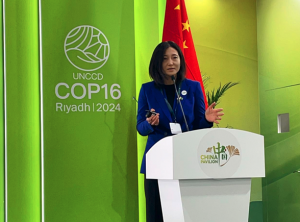
Krytal Li, CEO of Sunpure MEA&CA Sunpure Technology Co., Ltd.
Li Jing said that Sunpure Intelligent Robot Solution has higher reliability, mechanical wind lock and intelligent online strategy, and can withstand wind speeds up to 55 m/s. In terms of communication, one robot can link multiple LoRaWAN boxes for better communication quality and speed.
Sunpure Intelligent’s cutting-edge robot solution also makes innovations in design. The brush adopts the shape of bristles and edge design to eliminate dusty corners, and can automatically adjust the speed of the brush under different conditions to ensure that the cleaning efficiency is as high as 99.5%.
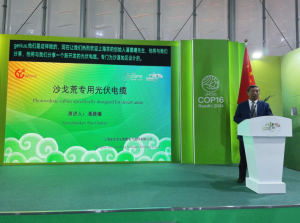
Pan Chenxi, founder of Shanghai Jinyou Jinhong Intelligent Electric Co., Ltd.
Pan Chenxi, founder of Shanghai Jinyou Jinhong Intelligent Electric Co., Ltd., introduced the photovoltaic cables specially designed for desert photovoltaic power station, the company’s business scope and basic situation.
Pan Chenxi said that our company not only has excellent products, but also has rich industry experience and successful cases. We have been committed to serving photovoltaic projects around the world. Our business not only covers many domestic central state-owned enterprises, but also exports to foreign regions such as the Middle East, Southeast Asia, and Australia.
Since 2016, Jinyou Jinhong has improved the original desert photovoltaic cables to adapt to the various harsh environments in desert areas and reduce the damage to the surface caused by construction sites and later maintenance in response to the different characteristics of different deserts. It has developed desert-specific photovoltaic cables that can be directly buried or overhead, which can be used not only in arid deserts, but also in high groundwater levels, and can be used to prevent rats, ants, small animals, and frost heave.
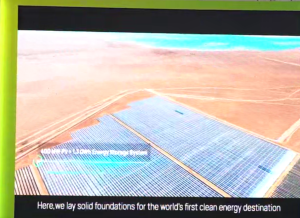
Huawei showcased the Saudi Red Sea project via a video
Huawei played a promotional video of its construction of the Saudi Red Sea New City project. The content of the promotional video shows that this is the world’s first city powered by 100% clean energy, powered by Huawei’s world’s largest photovoltaic storage microgrid power station, with a scale of 400MW photovoltaic + 1.3GWh energy storage system. Huawei relies on intelligent algorithms to ensure the stability of the entire microgrid system. Through the string architecture, the entire power grid can be started in minutes. Its high temperature resistance, wind and sand resistance, and salt spray resistance design have laid a solid foundation for the world’s first city with 100% clean power supply.
Subsequently, Wang Fuzhou, Chairman and Chief Engineer of R&D of Zhengzhou Zheng Sai Shield Co., Ltd, delivered a speech entitled “New Technology of Redundant Desertification Control”.
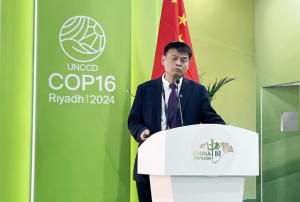
Wang Fuzhou, Chairman and Chief Engineer of R&D of Zhengzhou Zheng Sai Shield Co., Ltd.
Wang Fuzhou said that traditional desert planting practices have the disadvantages of large water consumption, high maintenance costs, limited ecological adaptability, insignificant soil improvement effects, and limited scale and speed. In order to cope with the huge challenges of desertification, Zhengsai Group has developed a new desertification control and improvement technology, namely deep water storage permeability reduction gas impermeability technology. The technology can effectively reduce water penetration by setting up an impermeable “isolation layer” at a certain depth in the desert to store water and reduce gas permeability, so that water can be retained in the roots of plants for a long time to meet the needs of plant growth.
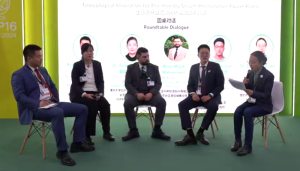
Guests discuss the relationship between photovoltaics and the ecological environment
In the subsequent dialogue session, Fan Jinglong, senior engineer of the Xinjiang Institute of Ecology and Geography of the Chinese Academy of Sciences, Ms. Hussein Kasim, negotiator of Ghana’s Climate Empowerment Action under the United Nations Framework Convention on Climate Change, and Dr. Jin Zhe of the School of Social Sciences of Tsinghua University participated in the dialogue discussion, and Dr. Zhang Huiwen of the School of Social Sciences of Tsinghua University served as the moderator of this session.
The guests discussed topics such as the impact of solar power plants on the environment, the importance of their site selection, and how environmental factors affect the reliability of power plants. The guests also analyzed the role of the government in promoting such projects and how photovoltaic panels can promote the recovery and development of ecosystems. Finally, the participants introduced the cooperation between Tsinghua University and the UN The RAP project, a CCD cooperation project, aims to promote the restoration of ecosystems through renewable energy.
The participants ended the meeting with a feeling of reluctance and a desire to leave. They had a deeper understanding of how the progress of photovoltaic technology introduced by different guests at the meeting complements the changes and development of the ecological environment and how to protect and improve the environment while promoting sustainable development.
They all agreed that the development of photovoltaic technology, as an important part of clean energy, not only helps to reduce greenhouse gas emissions, but also promotes the restoration of ecosystems and the protection of biodiversity. At the end of the meeting, the participants looked forward to more similar communication opportunities in the future to jointly promote the deep integration of photovoltaic technology and ecological and environmental protection.





